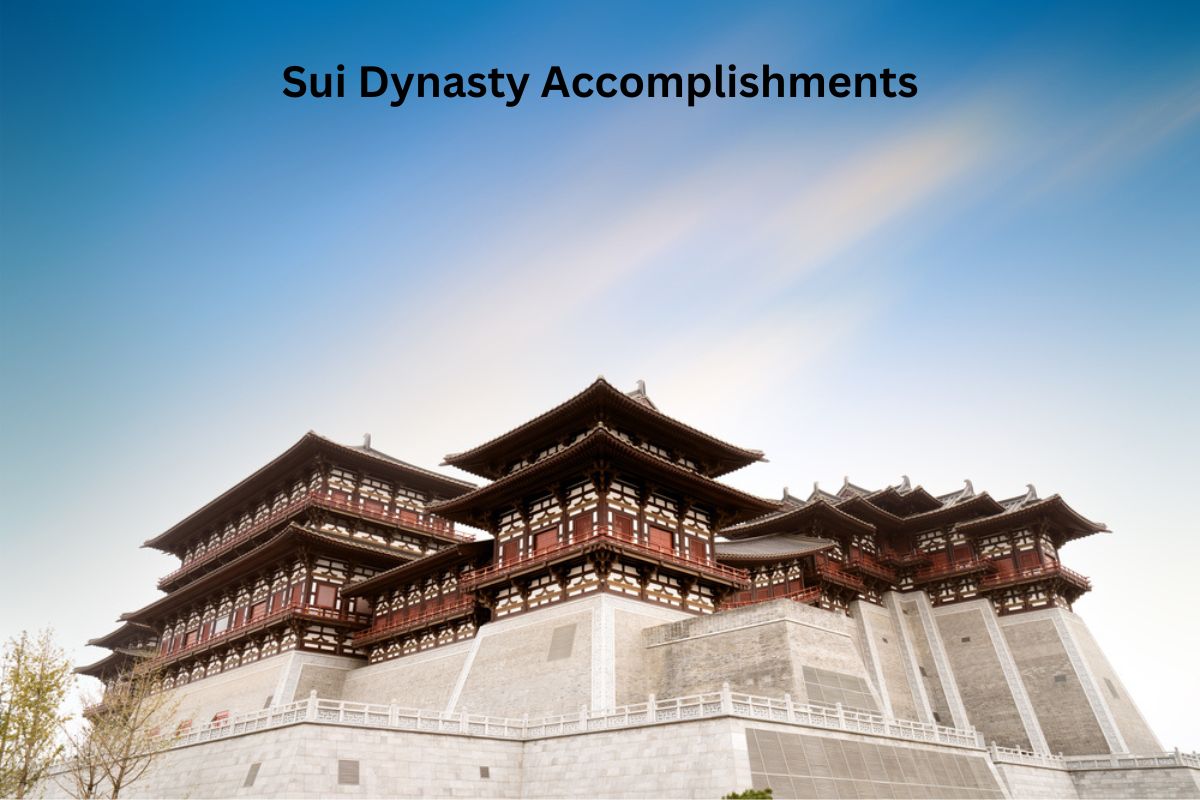The Sui Dynasty, which reigned from 581 to 618 CE, marked a pivotal era in Chinese history. With its relatively short existence, it left a lasting impact on governance, infrastructure, and culture.
Achieving reunification after a period of division, constructing the Grand Canal, and implementing administrative reforms, the Sui Dynasty laid the groundwork for subsequent dynasties.
Its accomplishments encompassed not only feats of engineering and governance but also cultural exchange and the promotion of Buddhism.
However, the dynasty also faced challenges arising from military campaigns and forced labor. This brief overview delves into the significant accomplishments and complexities that defined the Sui Dynasty’s legacy.
Accomplishments of the Sui Dynasty
1. Reunified China after a period of division
The Sui Dynasty’s most significant achievement was the reunification of China after several centuries of division following the collapse of the Han Dynasty. The country had been split into various competing states, leading to social, political, and economic turmoil.
Also Read: Facts About the Sui Dynasty
The Sui Dynasty, under the leadership of Emperor Wen and later Emperor Yang, managed to conquer and integrate the southern Chen Dynasty, reuniting northern and southern China.
This reunification brought stability and paved the way for subsequent dynasties, most notably the Tang Dynasty, which built upon the foundations laid by the Sui.
2. Built the Grand Canal for improved transportation
The Grand Canal was a monumental engineering feat that linked the Yellow River in the north to the Yangtze River in the south.
This extensive waterway system covered over 1,100 miles and played a crucial role in facilitating transportation, trade, and communication between the two major river valleys.
Also Read: Timeline of the Sui Dynasty
The Grand Canal allowed for the efficient movement of goods, agricultural products, and troops, which boosted economic development and cultural exchange. It not only enhanced the dynasty’s economic prosperity but also promoted cultural interaction between different regions of China.
3. Introduced administrative and legal reforms
The Sui Dynasty recognized the need to strengthen central governance and improve the efficiency of the administrative system.
To achieve this, Emperor Wen implemented a series of reforms aimed at reducing corruption, centralizing power, and ensuring a fairer distribution of resources. These reforms included land redistribution to benefit the poor, the implementation of a census system, and the restructuring of the bureaucracy.
The dynasty established a merit-based examination system to select officials based on their knowledge and abilities, setting a precedent for future dynasties. These administrative changes laid the groundwork for the more stable and enduring governance systems of the Tang Dynasty and beyond.
4. Continued the tradition of selecting officials through merit-based exams
The Sui Dynasty upheld the tradition of selecting government officials through a merit-based examination system.
This practice had been established in earlier dynasties but was further developed and institutionalized during the Sui period. The dynasty refined the examination process, emphasizing the importance of Confucian knowledge and moral character.
This system allowed talented individuals from various backgrounds to rise through the ranks based on their intellectual abilities, rather than solely through familial connections or social status.
This approach to selecting officials would become a hallmark of Chinese governance and was later expanded upon by subsequent dynasties, most notably the Tang and Song Dynasties.
5. Repaired and rebuilt sections of the Great Wall
The Sui Dynasty recognized the strategic importance of the Great Wall for defending China’s northern border against invasions by nomadic tribes.
Emperor Yang initiated projects to repair and strengthen the wall’s defenses, contributing to the dynasty’s efforts to enhance national security.
While the Great Wall had been built over centuries, the Sui Dynasty’s efforts demonstrated their commitment to maintaining and reinforcing this vital defensive structure.
6. Standardized weights and measures for trade
The Sui Dynasty introduced standardized systems for weights and measures, aiming to create consistency and fairness in trade transactions across different regions.
Prior to this standardization, the lack of uniformity in measurement systems could lead to confusion and disputes during trade, hindering economic activities.
The Sui Dynasty’s standardized weights and measures facilitated commerce by providing a common framework for transactions, reducing the risk of misunderstandings and promoting economic growth. This effort underscored the dynasty’s commitment to fostering a stable and prosperous economy.
7. Expanded the imperial palace in Chang’an
The Sui Dynasty invested in architectural projects that demonstrated the dynasty’s grandeur and authority. Emperor Yang oversaw the expansion of the imperial palace in Chang’an, the capital city.
This expansion included the construction of the Hall of Eternal Harmony (Yonghedian), an impressive structure used for important state ceremonies and gatherings. These architectural endeavors showcased the dynasty’s power and contributed to the overall visual representation of the Sui rulers’ authority.
8. Promoted the spread of Buddhism
While Confucianism had traditionally been the dominant philosophy in Chinese governance, the Sui Dynasty actively promoted Buddhism as well.
Emperor Wen and Emperor Yang both supported Buddhist monasteries and institutions, contributing to the dissemination of Buddhist teachings and practices throughout China.
This support for Buddhism had lasting cultural and religious impacts, as Buddhism continued to thrive and integrate into Chinese society in later dynasties.
9. Undertook military campaigns for territorial expansion
The Sui Dynasty embarked on several military campaigns to expand its territory and influence. These campaigns aimed to conquer and consolidate control over regions that had remained outside the Sui sphere.
While these campaigns did result in territorial gains, they also placed a strain on the population due to the demands of warfare, forced labor, and taxation. The military successes and challenges of the Sui Dynasty’s campaigns had far-reaching implications for its stability and eventual downfall.
10. Facilitated cultural exchange with neighboring regions
The Sui Dynasty maintained diplomatic relations with neighboring regions, particularly Central Asia. This facilitated the exchange of ideas, technologies, and goods between different cultures. The Silk Road, a network of trade routes, was crucial in facilitating this exchange.
The Sui Dynasty’s engagement with other cultures enriched Chinese society by introducing new elements and perspectives, contributing to the diversity of Chinese culture.
